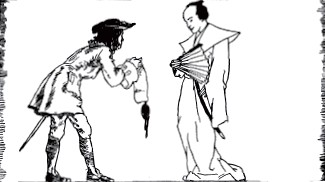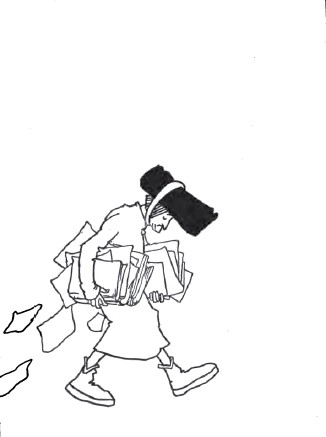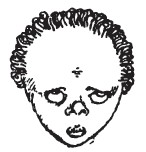| Web
and Book design,
Copyright, Kellscraft Studio 1999-2013 (Return to Web Text-ures) |
 (HOME)
|
 CHAPTER VIII The Author leaves Luggnagg, and sails to Japan. From whence he returns in a Dutch ship to Amsterdam, and from Amsterdam to England.
 THOUGHT this account of the struldbrugs
might be some
entertainment to the reader, because it seems to be a little out of
the common way; at least, I do not remember to have met the like in
any book of travels that hath come to my hands: and if I am deceived,
my excuse must be, that it is necessary for travellers, who describe
the same country, very often to agree in dwelling on the same
particulars, without deserving the censure of having borrowed or
transcribed from those who wrote before them. THOUGHT this account of the struldbrugs
might be some
entertainment to the reader, because it seems to be a little out of
the common way; at least, I do not remember to have met the like in
any book of travels that hath come to my hands: and if I am deceived,
my excuse must be, that it is necessary for travellers, who describe
the same country, very often to agree in dwelling on the same
particulars, without deserving the censure of having borrowed or
transcribed from those who wrote before them.
There is indeed a perpetual commerce between this kingdom and the great empire of Japan, and it is very probable that the Japanese authors may have given some accounts of the struldbrugs; but my stay in Japan was so short, and I was so entirely a stranger to that language, that I was not qualified to make any enquiries. But I hope the Dutch, upon this notice, will be curious and able enough to supply my defects. His Majesty having often pressed me to accept some employment in this court, and finding me absolutely determined to return to my native country, was pleased to give me his licence to depart, and honoured me with a letter of recommendation under his own hand to the Emperor of Japan. He likewise presented me with four hundred forty-four large pieces of gold (this nation delighting in even numbers), and a red diamond which I sold in England for eleven hundred pounds. On the 6th day of May, 1709, I took a solemn leave of his Majesty, and all my friends. This prince was so gracious as to order a guard to conduct me to Glanguenstald, which is a royal port to the south-west part of the island. In six days I found a vessel ready to carry me to Japan, and spent fifteen days in the voyage. We landed at a small port-town called Xamoschi, situated on the south-east part of Japan; the town lies on the western point, where there is a narrow strait, leading northward into a long arm of the sea, upon the north-west part of which, Yedo the metropolis stands. At landing, I showed the custom-house officers my letter from the King of Luggnagg to his Imperial Majesty. They knew the seal perfectly well; it was as broad as the palm of my hand. The impression was, a King lifting up a lame beggar from the earth. The magistrates of the town hearing of my letter, received me as a public minister. They provided me with carriages and servants, and bore my charges to Yedo, where I was admitted to an audience, and delivered my letter, which was opened with great ceremony, and explained to the Emperor by an interpreter, who then gave me notice by his Majesty's order, that I should signify my request, and, whatever it were, it should be granted for the sake of his royal brother of Luggnagg. This interpreter was a person employed to transact affairs with the Hollanders; he soon conjectured by my countenance that I was an European, and therefore repeated his Majesty's commands in Low Dutch, which he spoke perfectly well. I answered (as I had before determined,) that I was a Dutch merchant, shipwrecked in a very remote country, from whence I had travelled by sea and land to Luggnagg, and then took shipping for Japan, where I knew my countrymen often traded, and with some of these I hoped to get an opportunity of returning into Europe: I therefore most humbly entreated his royal favour, to give order, that I should be conducted in safety to Nangasac. To this I added another petition, that for the sake of my patron the King of Luggnagg, his Majesty would condescend to excuse my performing the ceremony imposed on my countrymen, of trampling upon the crucifix,1 because I had been thrown into his kingdom by my misfortunes, without any intention of trading. When this later petition was interpreted to the Emperor, he seemed a little surprised, and said, he believed I was the first of my countrymen who ever made any scruple in this point, and that he began to doubt whether I was a real Hollander, or no, but rather suspected I must be a Christian. However, for the reasons I had offered, but chiefly to gratify the King of Luggnagg by an uncommon mark of his favour, he would comply with the singularity of my humour; but the affair must be managed with dexterity, and his officers should be commanded to let me pass as it were by forgetfulness. For he assured me, that if the secret should be discovered by my countrymen, the Dutch, they would cut my throat in the voyage. I returned my thanks by the interpreter for so unusual a favour, and some troops being at that time on their march to Nangasac, the commanding officer had orders to convey me safe thither, with particular instructions about the business of the crucifix. On the 9th day of June, 1709, I arrived at Nangasac, after a very long and troublesome journey. I soon fell into the company of some Dutch sailors belonging to the Amboyna, of Amsterdam, a stout ship of 450 tons. I had lived long in Holland, pursuing my studies at Leyden, and I spoke Dutch well. The seamen soon knew from whence I came last: they were curious to enquire into my voyages and course of life. I made up a story as short and probable as I could, but concealed the greatest part. I knew many persons in Holland; I was able to invent names of my parents, whom I pretended to be obscure people in the province of Guelderland. I would have given the captain (one Theodorus Vangrult) what he pleased to ask for my voyage to Holland; but understanding I was a surgeon, he was contented to take half the usual rate, on condition that I would serve him in the way of my calling. Before we took shipping, I was often asked by some of the crew, whether I had performed the ceremony above-mentioned? I evaded the question by general answers, that I had satisfied the Emperor and court in all particulars. However, a malicious rogue of a skipper went to an officer, and pointing to me, told him I had not yet trampled on the crucifix: but the other, who had received instructions to let me pass, gave the rascal twenty strokes on the shoulders with a bamboo, after which I was no more troubled with such questions. Nothing happened worth mentioning in this voyage. We sailed with a fair wind to the Cape of Good Hope, where we stayed only to take in fresh water. On the loth of April, 1710, we arrived safe at Amsterdam, having lost only three men by sickness in the voyage, and a fourth who fell from the foremast into the sea, not far from the coast of Guinea. From Amsterdam I soon after set sail for England in a small vessel belonging to that city. On
the 16th of April we put in at the Downs. I landed the next morning,
and saw once more my native country after an absence of five years
and six months complete. I went straight to Redriff, where I arrived
the same day at two in the afternoon, and found my wife and family in
good health. 

__________
1 Europeans, at the time, were required by the Japanese authorities to trample on the symbol of Christianity before entering the country for the purpose of trading. |